Look inside Apple’s new downtown L.A. store and event space, a symbol of its Hollywood ambitions
The Broadway theater that introduced Angelenos to “talkie” movies nearly a century ago is throwing open its doors Thursday in a vastly different entertainment era as a gilded Apple store. The tech giant intends the retail and event space to be one of its most prominent and a symbol of its emergence as a creative force in Hollywood.
Downtown Los Angeles backers hope the high-profile store debut will inspire other retailers to open in the city center, where many businesses were hit hard by pandemic-related closures that robbed streets of life and kept people out of their establishments.
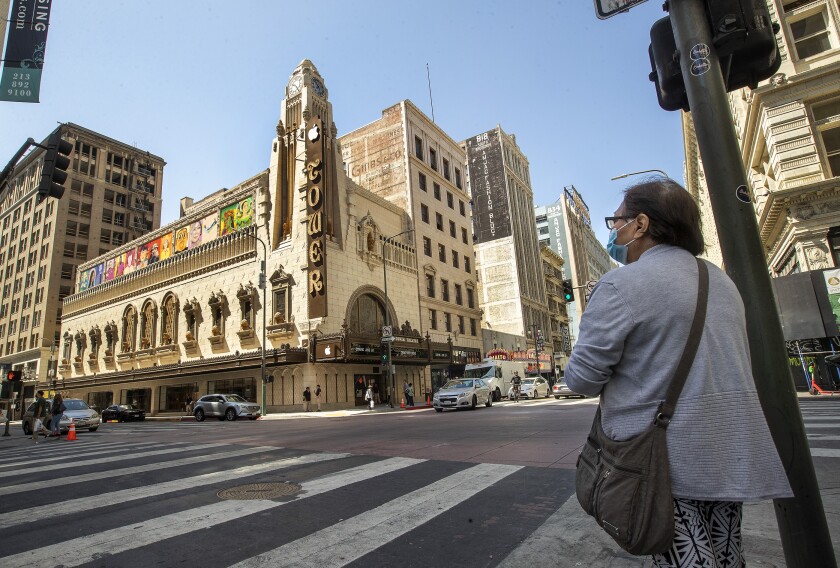
The Apple Tower Theatre store and event space stands at Broadway and 8th Street in downtown Los Angeles.
(Mel Melcon / Los Angeles Times)
The converted cinema is an amped-up and reimagined version of Apple’s normal store format, meant to showcase the company’s multiple content creation visions: There’s plenty of tech to buy, but Apple also plans programs, classes and other events involving well-known filmmakers, musicians and artists.
Apple wouldn’t say how much it spent renovating the once-derelict Tower Theatre, but the evidently multimillion-dollar makeover was in the works for more than three years and included painstaking restoration of many of the theater’s original features, such as ceiling murals of ethereal cloud-patched skies.
It was one of the finest theaters in the city when it opened in 1927 to show silent films, but it was soon converted to show talking pictures and hosted the Los Angeles premiere of “The Jazz Singer,” starring Al Jolson.
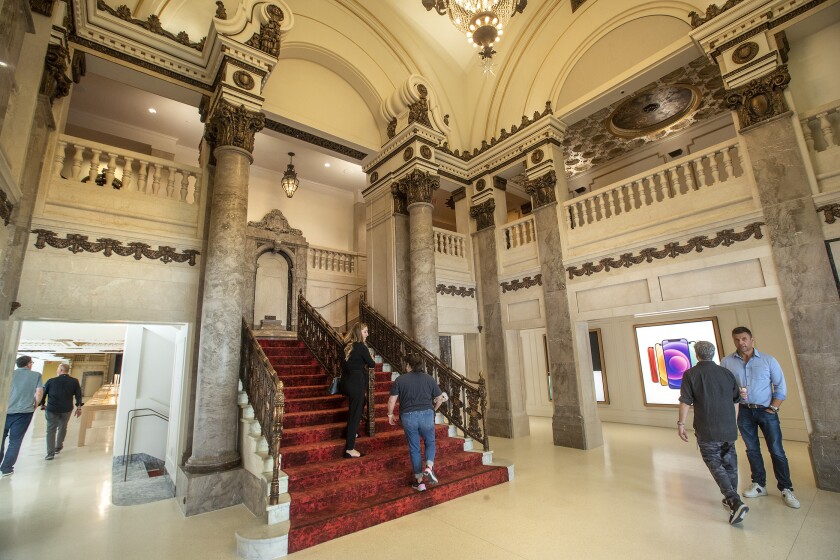
People walk up the restored monumental staircase with marble treads inside the Apple Tower Theatre.
(Mel Melcon / Los Angeles Times)
The theater was one of the first air-conditioned buildings in the city and originally sported windows on the underground level that patrons could look through to marvel at the cutting-edge cooling equipment.
Built on a small site for a theater and seating only 900, it was designed in Renaissance Revival style with innovative French, Spanish, Moorish and Italian elements cast in terra cotta, according to the Los Angeles Conservancy. The theater closed in 1988.
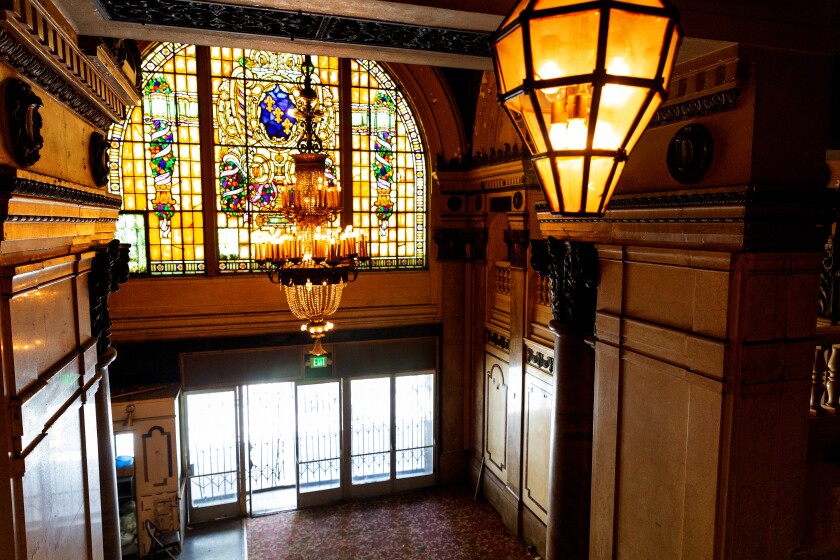
The lobby of the Tower Theatre, shown in 2018 before the renovation, features an ornate crystal chandelier and stained glass windows.
(Robert Goulrey / Los Angeles Times)
Apple’s design team relied on historical photos and architectural drawings as well as modern 3-D laser scans to aid the renovation, which included seismic upgrades.
Apple conducted forensic paint studies “and literally peeled back history” to reveal the original details and luminous light colors that gave the Tower Theatre its beauty, said architect Doo Ho Lee, design director for Apple’s retail stores.
Workers found rich gold and detailed bronze elements, as well as bright stone and ornate plaster work, Lee said. Artisans restored, painted and polished each surface by hand.
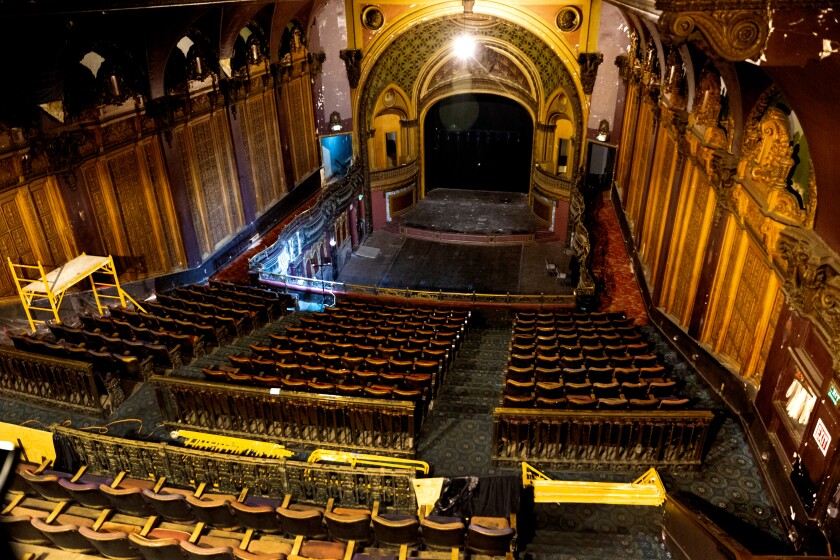
The Tower Theatre interior, shown in 2018, has been converted into a retail store and interactive event space.
(Robert Goulrey / Los Angeles Times)
Outside, Apple created a replica of the clock tower cap, which had been damaged and then removed following the 1971 Sylmar earthquake. Artisans also re-created the 1927 Broadway marquee design by hand sculpting its crest and details from historical photos.
“The beautiful entrance is now fully restored to its opening glory,” Lee said. Notable details include a grand staircase with bronze handrails flanked by marble Corinthian columns and surrounded by balcony landings set off by a crystal chandelier.
“It has a real sense of procession and dynamic theater as one circulates through the space,” he said. Looking back toward the entrance, visitors see a stained-glass window depicting a fleur-de-lis pattern and a celluloid film strip.
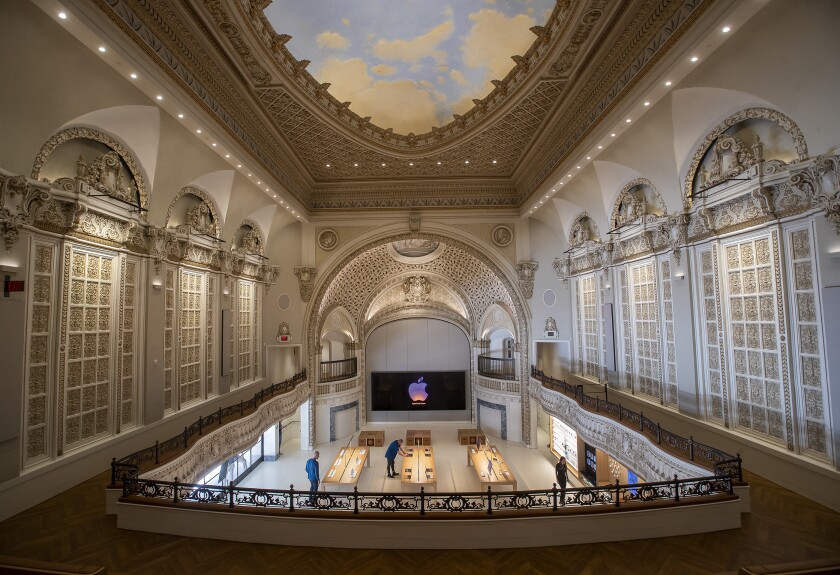
From the balcony inside the Apple Tower Theatre in downtown Los Angeles, visitors can see the store on the ground level.
(Mel Melcon / Los Angeles Times)
Inside the former theater is the main product zone, surrounded by a 1920s vision of grandeur conjured by architect S. Charles Lee to mimic the Paris Opera House. It was the first of several movie palaces designed by Lee, who was also the architect of the elaborate Los Angeles Theater.
Where the movie screen once stood is a video wall, framed behind the proscenium arch and Juliet balconies that offer the best view of the five-story interior.
Apple Tower Theatre stands apart from other stores because “it is such a special building and has such significance in the film industry,” said Deirdre O’Brien, head of retail and personnel for Apple.
“It’s in the heart of a city that is known for creativity and we really want to build upon that,” she said. Apple has 25 stores in the Greater Los Angeles area.
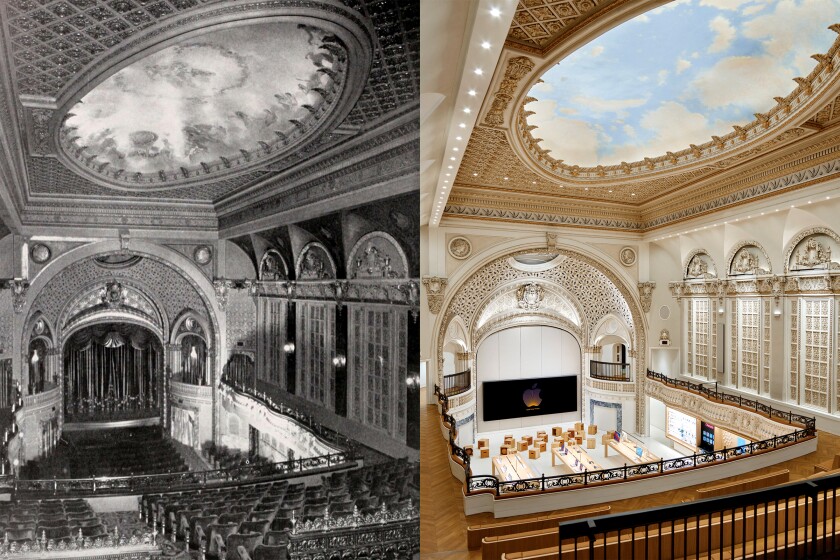
The old Tower Theatre, at left, showed the first sound movie to Angelenos in 1927. Apple is opening its newest retail location after one of its most significant restoration projects.
(Apple)
The Tower Theatre branch has been “highly anticipated” by downtown stakeholders who hope for a ripple effect from its presumed popularity, real estate broker Derrick Moore of CBRE said.
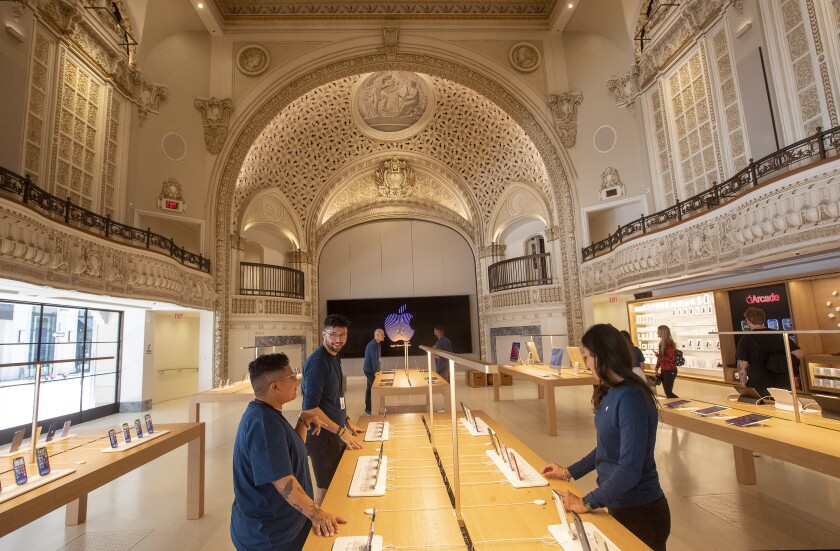
The ground level of the Apple Tower Theatre contains space for retailing, education and events.
(Mel Melcon / Los Angeles Times)
Downtown businesses such as shops and restaurants suffered more than those in other urban nodes of the region over the last year because they relied so much on hundreds of thousands of daily office workers who fled during the pandemic and are mostly still doing their jobs at home. Also missing were tourists and local sports and music fans.
Retail building vacancies downtown nearly doubled to 4.4% in the second quarter, compared with the same period in 2020, CBRE said. Many stores, bars and restaurants remain closed, however, even if their owners are still paying rent.
Although security keycard provider Kastle Systems estimates that offices in the Greater Los Angeles area were about 26% occupied by workers last week, Moore calculated office occupancy downtown at closer to 11% and said it may not spring back until after Labor Day, when many U.S. companies have said they expect to be back in their buildings more fully.
The stretch of Broadway near Olympic Boulevard where the former theater lies was one of the most up-and-coming before the pandemic, with new apartments and renovations of historic offices and stores, Moore said.
The neighborhood began to improve when the Ace hotel and theater complex opened there in 2014 in the former United Artists building and became a popular destination for lodging and entertainment.
The 1.1-million-square-foot Broadway Trade Center across the street from the Tower is set to be redeveloped into an office, hotel and retail complex, but remains unfinished.
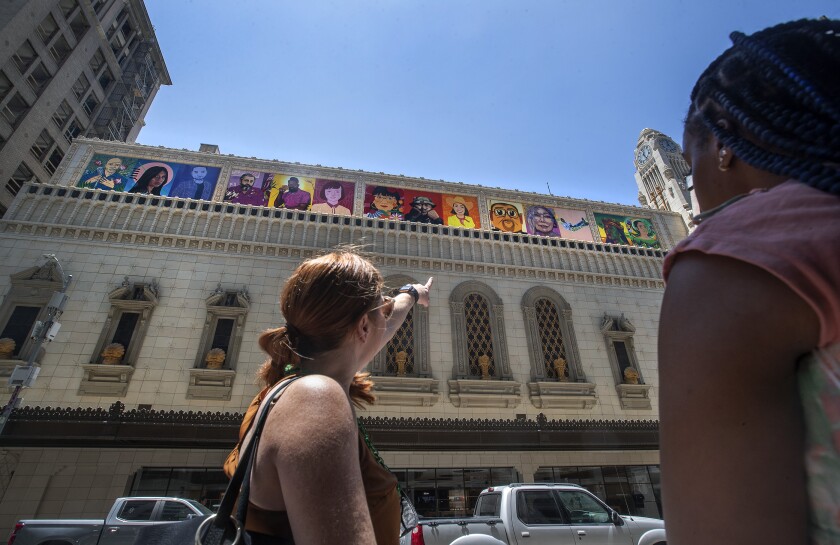
Rene Hodges, left, points out portraits created by local artists of people who inspired them creatively. Hodges helped produce the project, which decorates the 8th Street exterior of the Apple Tower Theatre store and event space.
(Mel Melcon / Los Angeles Times)
Neighbors include a Vans shoe store and Urban Outfitters, which occupies the former Rialto Theatre. Also across the street is a 1915 office building clad in white marble that has been restored but has no tenants yet.
Apple’s decision to invest there as a tenant is a validation of its real estate location, Moore said, perhaps bringing enough cachet to persuade other high-end retailers to join it downtown.
“The significance of the brand cannot be understated,” he said.
The theater building is owned by the Delijani family, which also owns the Los Angeles Theatre and two other historic Broadway movie houses.
The Cupertino, Calif.-based company has rapidly increased its presence in the Los Angeles area in recent years as its Apple TV+ became a competitor to other streaming entertainment services such as Netflix and Amazon Prime Video. Apple announced in April that it would grow its teams in Culver City to more than 3,000 employees by 2026 and expand its campus there. The company employs about 9,000 workers in the L.A. area now, including nearly 100 at the newest store.
The downtown Apple store and another in Beijing will be the first to launch Apple Creative Studios, which the company calls “a global initiative for underrepresented young creatives” to give them access to tech equipment, guidance and the opportunity to display what they create.
The company’s Today at Apple program will also offer public in-store sessions at Tower Theatre and virtual sessions hosted by Creative Studios teaching artists including photographer and filmmaker Bethany Mollenkof, rapper and producer D Smoke, singer-songwriter Syd, and cellist and singer Kelsey Lu.
Downtown booster Jessica Lall hopes such programs and Apple’s presence will broaden the appeal of the city center as people return in search of its urban environment after what she described as “a really hard year for downtown.”
“You go there for connection, for entertainment, for cultural experiences in life,” said Lall, president of business advocacy group Central City Assn. of Los Angeles. With pandemic restrictions lifting, “we’re seeing just how swiftly people are coming back and how excited they are. It’s visible and palpable.”
